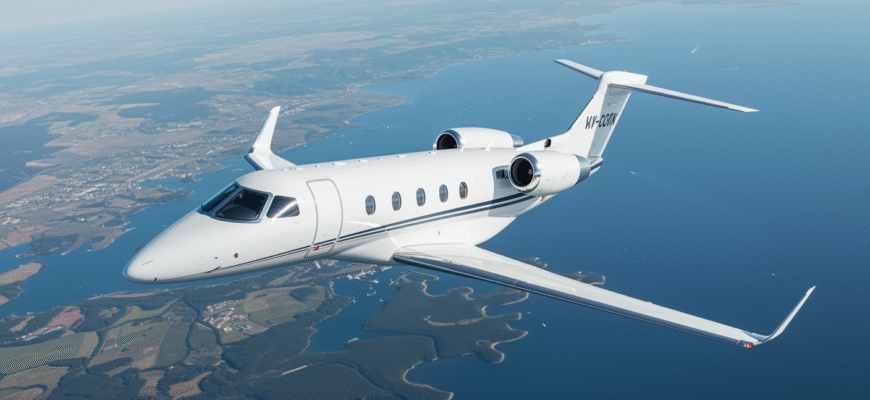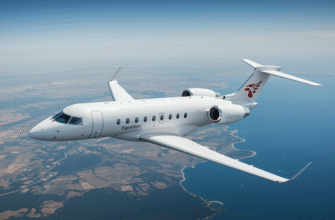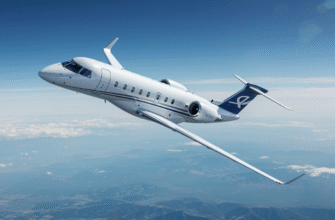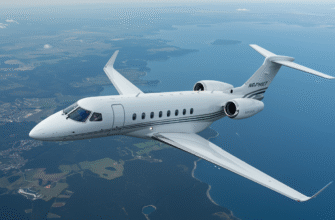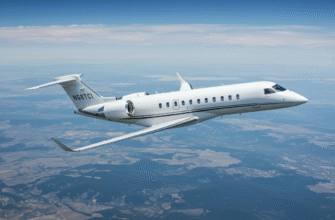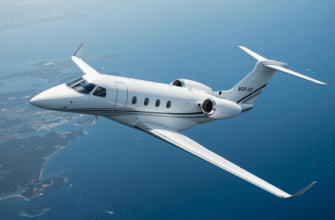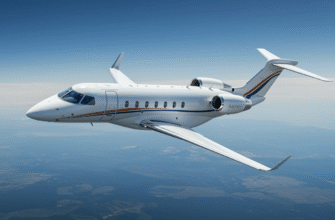Not everyone who wants to fly private is shopping for a mid-size jet with a flight attendant and a New York–to–LA range. Some just want speed, comfort, and simplicity without compromising on quality—or spending $10 million. That’s where the Embraer Phenom 100 and 100E come in.
These jets cater to a specific type of flyer: owner-pilots, short-haul charter clients, and corporate flight departments looking for ease and efficiency.
But don’t mistake “light” for basic. These aircraft feel more like small private suites than stripped-down shuttles. With dynamic performance, a polished cabin, and the same digital cockpit tech found in larger aircraft, the Phenom 100 series gave the Very Light Jet category a much-needed upgrade.
From first solo flight to first-class curb appeal on the ramp, the Phenom 100 and 100E are sleek, street-smart jets with a surprisingly luxurious handle.
Overview Of The Embraer Phenom 100 And 100E
In private jet terms, a Very Light Jet (VLJ) means super compact with a max takeoff weight under 10,000 lb, usually seating 4–7 people. But don’t let the size fool you—the Embraer Phenom 100 series slides into this category with the swagger of a much bigger bird.
Both the Phenom 100 and its successor, the 100E, offer short-range business jet travel without cutting corners on tech or interior design. Their mission?
Quick regional hops under 1,200 nm, easy single-pilot ops, and a level of comfort usually saved for larger cabins.
They’re also incredibly efficient, making them ideal for pilot training, first-time owners, and charter services operating high-cycle, short-stage flights.
The series stands out for its full authority digital engine controls (FADEC), pressurized cabin, and top cruising speeds just shy of 400 knots—true bizjet traits in a downsized frame.
Phenom 100 Vs. Phenom 100E Differences
The Phenom 100E isn’t a total redesign—it’s a finesse act. Think software upgrade rather than all-new hardware.
What it brought to the table were spoilers to reduce stopping distance, smoother brake-by-wire tech, and improved avionics interfaces for a smarter cockpit feel.
Pilots note the added confidence during landings, especially on shorter runways.
From the outside, you’d never immediately spot a difference—but inside the cockpit, the evolution is noticeable with faster system responsiveness and greater customization.
Some long-time operators prefer the original 100 for its simplicity and slightly lower price on the secondary market.
Others lean toward the 100E because of its trim upgrades and tighter handling. Either way, you’re getting a VLJ with serious respect in the air and on the ramp.
Who This Jet Was Built For
This aircraft wasn’t built for folks who hire a crew to pour bubbly. It was imagined for the type of person who flies their own machine, wants the reliability of a business-class jet, and wants all of it for under $4 million.
Owner-pilots especially love that the Phenom 100 and 100E are single-pilot certified, easy to manage, and offer “big jet” aesthetics—glass cockpit, roomy cabin, and legit baggage room.
For charter companies, it’s about a smart ROI. These jets sip fuel, can turn quickly between missions, and still feel upscale for high-end passengers—often running point-to-point routes under two hours.
And flight schools? They’ve latched onto the Phenom 100 series as multi-engine trainers that actually feel and fly like jets. Easy to operate, predictable to land, and fast enough to prep future corporate pilots.
- Solo business owners & leisure fliers
- Corporate shuttle operations
- Boutique air taxi services
- Accelerated jet training programs
Performance & Specs Breakdown
What matters most in this category is the ability to launch, climb, land, and turn fast—without losing your shirt on fuel. The Phenom 100 and 100E hit all those metrics.
With a range of about 1,160 nautical miles, they’re perfect for city-to-city legs like Dallas to Chicago or Geneva to Prague. Max cruise speeds lick 390–400 knots, and they climb to FL370 in under 25 minutes—meaning you’re well above the weather in minutes.
Runway-wise, the 100E needs just over 3,100 feet for takeoff and around 2,500–3,100 feet to land depending on weight and conditions. Translation? It fits into a lot of regional airports that keep you closer to where you actually want to be.
Performance-wise, it compares closely to the Citation Mustang but with more usable cabin volume and a higher cruise speed. Against the Citation M2, it holds its own, though the M2 edges out in top-end avionics and marginally better short-field ops.
| Spec | Phenom 100 / 100E |
|---|---|
| Max Range | 1,160 nm |
| Normal Cruise Speed | 370 knots |
| Takeoff Distance | 3,190–3,400 ft |
| Climb to 37,000 ft | ~23 minutes |
| Max Occupancy | Up to 7 |
How It Feels To Fly The Phenom 100
Flying one of these feels more like sports car than spacecraft. The Phenom 100 was designed to boost confidence—especially for pilots transitioning from turboprops or piston twins.
With FADEC-controlled engines, startup is basically push-and-go. No juggling throttles or second-guessing engine settings.
The Garmin G1000 cockpit feels almost intuitive—it lays out the flight plan, weather, terrain, and engine data in a way even new jet pilots find digestible. Later versions with the G3000 suite are even more refined.
Handling is just honest—predictable on approach, stable in cruise, and responsive enough that you don’t feel disconnected. That’s huge for solo pilots managing everything from callouts to checklists on their own.
Owner-pilots often describe the transition as “oddly natural.” This isn’t a plane that punishes small mistakes. Instead, it doubles down on helping you fly smooth, look good, and land sharp. That’s why so many use it as their first true jet experience.
Interior Experience: Quiet Luxury Without Overstating
A lot of people assume “entry-level jet” means cramped cabins, plasticky finishes, and loud cabins. That’s not the case with the Phenom 100 or 100E. Once inside, you forget you’re in the smallest class of private jets. The flat-floor cabin doesn’t just give you psychological comfort — it actually makes movement easier, especially mid-flight. Plush swivel chairs and windows placed higher on the fuselage amplify natural light and reduce that boxed-in vibe.
Custom finishes help push the look upscale. You’ll find real wood veneers, fine leather stitching, and metallic subtly integrated trim that gives off CEO-in-the-back vibes without sounding every alarm for “tryhard.” Instead, it channels that low-key “I made it” energy, similar to a well-tailored blazer with no flashy labels.
The lavatory, often a pain point in VLJs, has been cleverly reimagined here. You’re not doing yoga to use it, and the belted option even adds a seventh usable seat when needed. That plus the rare-for-class heated external baggage bay — big enough to stash skis or golf bags — makes this compact jet way more road (or sky) trip–ready than it looks from the tarmac.
Cost to Own + Operate
Sticker shock doesn’t hit too hard with the Phenom 100E. Pre-owned models hover around the $2.9 million mark, depending on hours and avionics. The earlier Phenom 100s go for closer to $2 million or less, and financing usually lands you somewhere around $6K/month over 10 years.
Fuel and maintenance are where jets either eat you alive or surprise you pleasantly. The Phenom does the latter, burning ~$2,000/hour on typical ops — a sweet spot for its size class. Maintenance plans are widely available, and the brake-by-wire system cuts down on wear-and-tear costs, too.
- Insurance: Most owners pay $20K–$35K annually, depending on hours and pilot experience.
- Fuel burn: Roughly 90–95 gallons per hour cruise.
- Hangar or ramp fee: Compact wingspan and lower MTOW work in your favor; solo owners often slip into small regional spaces with minimal storage rates.
For single-owner pilots or tiny teams, it checks the boxes: affordable, efficient, and flexible enough not to derail your lifestyle.
Modifications & Upgrades Available
Tech moves fast, and the Phenom doesn’t stay stuck in 2008 just because that’s when it launched. Plenty of owners opt for Garmin upgrades, like GTN 750Xi series panels, for intuitive performance and modern feel. That paired with Wi-Fi kits means passengers stream and scroll comfortably.
You’ll see upgraded seat foams, custom upholstery rewraps, and better cabin insulation from soundproofing kits. If you’re doing 2-hour hops with demanding clients — or just want it to feel quieter and cooler — these mods bring it closer to large-jet comfort levels.
Resale, Longevity & Value Retention
The Phenom 100 and 100E continue holding interest from first-time buyers and schools — and it’s not just nostalgia. You’re getting single-pilot capability with style, and operating costs that beat most turboprops.
Common upgrade pathways? Many move up to the Phenom 300 once their flight profile ramps up. But plenty don’t leave at all. Solo biz owners, charter startups, and high-time instructors stick with the 100 for its durability, simplicity, and class-leading reliability. It holds its own — year after year.
How It Compares to Other VLJs in the Real World
Put it side by side with the Citation Mustang or Eclipse 500, and the Phenom 100 usually wins on space, speed, and comfort. It’s got a more refined look and feel, less “plastic jet” and more “mini Gulfstream.” Compared to the HondaJet? That one’s snazzier and faster, but the Phenom feels more solid, like it could take a hit and keep flying.
It’s that “big jet energy” squeezed into a VLJ airframe that keeps people coming back again and again.
Final Thoughts for Buyers, Dreamers, and Pilots
If you’re a pilot-owner wanting your first jet or a small firm needing point-to-point speed, the Phenom 100 deserves a serious look. It’s manageable without a crew, flyable without burnout, and stylish without screaming for attention.
The world calls it “entry-level,” but it doesn’t feel that way. Everything inside — from FADEC simplicity to cabin luxe — flips the script. This jet doesn’t just get you from point A to point B. It makes you feel like the kind of person who doesn’t settle on anything less than smart, sleek, and quietly powerful.
